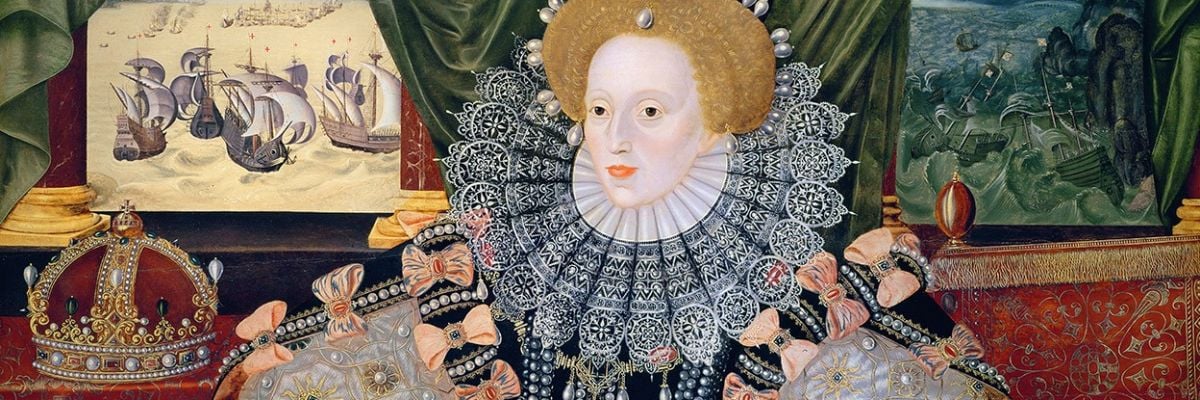
The day, long feared by Catholics, had arrived. Beloved Queen Mary’s five-year reign ended with her death while she was hearing Mass on November 17, 1558.
The daughter of King Henry VIII and Catherine of Aragon proved a brave ruler, who deemed it God’s will to see the Catholic Faith openly practiced in the kingdom once more. Although her father, in order to be free of his wife, had taken the initial step of controlling the Church in England, the crown did not embrace heretical doctrine until the rule of her half-brother Edward VI (son of Henry and Jane Seymour).
Edward’s reign marked the expunging of the Faith and the use of force and penalties to impose the Protestant heresy on the Catholic people of England. But Edward was a sickly boy and his reign ended after six years. The men at the royal court responsible for implementing Protestant teaching and worship on the people, chief among them Thomas Cranmer, were brought to justice under Mary’s reign.
The Catholic Church flourished during the time of the beloved queen (the later moniker “bloody” associated with her name, applied by Protestant historians, is a travesty of charity) but fear always lurked behind the scenes. The queen was not married when she assumed the throne at the age of thirty-seven, but that was soon remedied with nuptials to Prince Philip of Spain. Sadly, the union produced no heir, which fueled the fear that Mary’s Protestant half-sister Elizabeth Tudor (daughter of King Henry and Anne Boleyn) would assume the throne upon Mary’s death.
English Catholics believed the legitimate heir to the English crown was Mary Stuart, Queen of Scots (r. 1542–1567) because of her Catholic faith and relationship to the Tudor line (she was the granddaughter of Margaret Tudor, Henry VIII’s sister). However, political intrigue, not the least of which was the religious revolution in Scotland unleashed by the Protestant revolutionary, John Knox, prevented Mary Stuart from assuming the English throne.
Raised Protestant, Elizabeth spent much of her forty-five years upon the throne violently suppressing the Catholic Faith in England. One of the longest reigning monarchs in English history, Elizabeth is widely known as “Good Queen Bess”—a strong, independent, intelligent “Virgin Queen” who led her people into an era of unprecedented prosperity and represented the strong Protestantism of her people.
This narrative is, as Catholic historian Hilaire Belloc aptly described, “a monstrous scaffolding of poisonous nonsense.” In reality, Elizabeth was a figurehead monarch controlled behind the scenes by powerful men, who had been enriched by the dissolution of the Catholic monasteries under Henry and had an economic incentive to prevent the permanent restoration of the Catholic Faith in England.
English Catholics during the time of Elizabeth suffered greatly under the first state-sanctioned persecution of the Catholic Church since the Roman Empire. The first salvos in a long legislative campaign to eradicate the Catholic faith in England began in 1559, when Elizabeth was declared the Chief Governor of all Spiritual and Ecclesiastical Affairs in England by the Act of Supremacy, which required all clergy and university professors to take an oath of loyalty to her as head of the Church. Refusal to take the oath resulted in confiscation of property, imprisonment, and the possibility of the death penalty.
Another piece of legislation, the Act of Uniformity, restored Protestant worship in England and required every citizen to attend Church of England services; refusal to do so was punished by heavy fines. This legislation also declared it a crime to believe the pope is the head of the Church in England. Other anti-Catholic legislation passed during Elizabeth’s reign included a law that made conversion to the Catholic Faith a treasonous act punishable by death. When Jesuit missionaries arrived in the embattled nation to minister to the underground Church, laws were passed making it a criminal offense (aiding and abetting rebellion) to harbor or assist a Jesuit priest.
The attack on the Church in Elizabethan England required a response, especially if the Faith was to survive, even underground. William Cardinal Allen soon recognized the need for Englishmen to be trained abroad for the priesthood and then sent back to England, so in 1568 he established a seminary across the Channel in Douai (now part of France) known as the English College. Once ordained, the seminary’s graduates would return home clandestinely to care for the persecuted faithful.
One such priest, Cuthbert Mayne (1544–1577), arrived secretly in England on April 24, 1576. He ministered to the underground Church for just over a year until he was arrested on June 8, 1577 and sentenced to death. He was given the opportunity to save his life by recanting his Catholic faith by swearing on a Bible that Elizabeth was the head of the Church. Fr. Mayne took the Bible made the sign of the cross and said, “The Queen never was, nor is, nor ever shall be the head of the Church!” He was executed in the horrific manner of being hanged, drawn, and quartered and was the first of many martyred priests in Elizabethan England.
The popes had watched with great concern the persecution of the Church and supported efforts to minister to the underground Catholics in England. Eventually, one pope believed it was time for a radical response.
Upon his election to the papacy, Michele Cardinal Ghislieri took the name Pius V. Racked by the Protestant Revolution throughout Europe, the Church needed a vigorous response. Although the Catholic Reformation had begun under his predecessors, it was Pope St. Pius V (r. 1566–1572) who implemented the great Reform and set the Church on the path of restoration and recovery. A holy Dominican and former head of the Holy Office of the Inquisition in Rome, Pius was resolute in providing relief to the embattled Catholics in England. Elizabeth had been on the throne for twelve years and the efforts of previous pontiffs working with secular rulers to alleviate the sufferings of English Catholics had proved lacking. So, Pius V decided it was time to excommunicate the queen and call for her overthrow.
On April 27, 1570, Pius promulgated the bull Regnans in Excelsis, in which the “pretended queen of England and the servant of crime” was excommunicated for embracing the “errors of heretics.” The bull outlined the persecution of Catholics under Elizabeth and declared her deposed. All loyalty due her as monarch was revoked. Pius hoped the bull would spark a revolt in England and lead to Elizabeth’s overthrow.
This was not the first time a pontiff had excommunicated a secular ruler and called for a revolution. As with many previous examples, however, this effort failed to achieve its goal and even backfired. It was exploited by Elizabeth and her advisors, chiefly William Cecil (1520–1598), as “proof” that one could not be both Catholic and a loyal Englishman. During the following thirty-three years of Elizabeth’s reign, the Church saw six more pontificates. She continued her bloody persecution of Catholics in England, but the Faith would persevere as a result of the blood of the martyrs.



